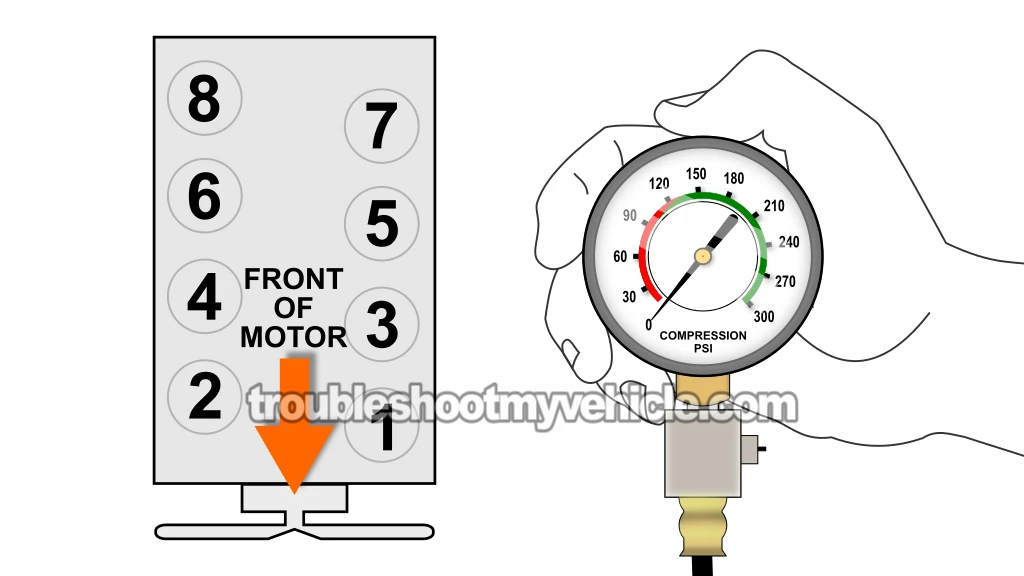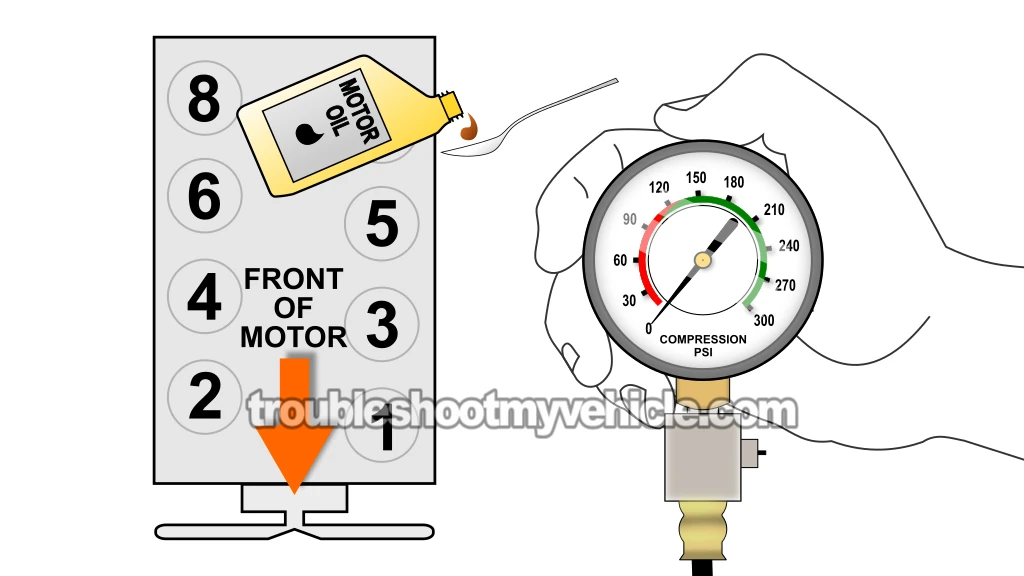
Checking the engine compression on your Dodge Ram van with the 5.2L or 5.9L V8 might seem intimidating, but it's actually a pretty straightforward job.
In this tutorial, I'll walk you through the steps to perform a compression test —and just as importantly, I'll explain how to understand what the results mean.
Why bother with a compression test? Because it can help you figure out whether the engine is worn out. It's a valuable diagnostic step if your van won't start, or if you're chasing down a stubborn misfire that's been tough to pinpoint.
Contents of this tutorial:
APPLIES TO: This tutorial applies to the following vehicles:
- 1989-1994:
- Dodge Ram B150 Van 5.2L V8: 1989, 1990, 1991, 1992, 1993, 1994.
- Dodge Ram B250 Van 5.2L V8: 1989, 1990, 1991, 1992, 1993, 1994.
- Dodge Ram B250 Van 5.9L V8: 1989, 1990, 1991, 1992, 1993, 1994.
- Dodge Ram B350 Van 5.9L V8: 1989, 1990, 1991, 1992, 1993, 1994.
- 1995-1997:
- Dodge Ram B1500 Van 5.2L V8: 1995, 1996, 1997.
- Dodge Ram B2500 Van 5.2L V8: 1995, 1996, 1997.
- Dodge Ram B3500 Van 5.2L V8: 1995, 1996, 1997.
- Dodge Ram B2500 Van 5.9L V8: 1995, 1996, 1997.
- Dodge Ram B3500 Van 5.9L V8: 1995, 1996, 1997.
- 1998-2003:
- Dodge Ram 1500 Van 5.2L V8: 1998, 1999, 2000, 2001, 2002, 2003.
- Dodge Ram 2500 Van 5.2L V8: 1998, 1999, 2000, 2001, 2002, 2003.
- Dodge Ram 3500 Van 5.2L V8: 1998, 1999, 2000, 2001, 2002, 2003.
- Dodge Ram 1500 Van 5.9L V8: 1998, 1999, 2000, 2001, 2002, 2003.
- Dodge Ram 2500 Van 5.9L V8: 1998, 1999, 2000, 2001, 2002, 2003.
- Dodge Ram 3500 Van 5.9L V8: 1998, 1999, 2000, 2001, 2002, 2003.
Symptoms Of Engine Compression Problems
In most cases, engine compression issues lead to one of two main problems:
- Engine no-start: Either the compression is so low that the engine won't start at all.
- Cylinder misfire: The engine manages to start and run, but it does so with a noticeable misfire.
If a misfire is happening because of a compression-related issue (and your Dodge Ram van is equipped with OBD II) you're likely to see one or more of these diagnostic trouble codes pop up:
- P0300: Random/Multiple Cylinder Misfire Detected.
- P0301: Misfire Detected in Cylinder #1.
- P0302: Misfire Detected in Cylinder #2.
- P0303: Misfire Detected in Cylinder #3.
- P0304: Misfire Detected in Cylinder #4.
- P0305: Misfire Detected in Cylinder #5.
- P0306: Misfire Detected in Cylinder #6.
- P0307: Misfire Detected in Cylinder #7.
- P0308: Misfire Detected in Cylinder #8.
You might also experience these symptoms:
- Rough idle: The engine idles roughly, though no misfire code is triggered. Once you press the gas, the roughness fades.
- Misfire under load: The misfire only shows up when you accelerate the vehicle.
- Idle-only misfire: Misfire is felt while idling but disappears as RPMs increase.
- Poor fuel economy: Because some cylinders aren't contributing evenly, fuel efficiency takes a hit.
- Strong exhaust odor: A noticeable, heavy exhaust smell may come from the tailpipe when the engine is running.
Important Tips And Suggestions
TIP 1 –Always start with a cold engine: Make sure the engine has completely cooled down before you begin removing the spark plugs.
Taking spark plugs out of a hot engine can strip or damage the threads in the spark plug holes —something you definitely don't want to deal with.
TIP 2 –Use a proper spark plug wire puller: When it's time to disconnect the spark plug wires, a spark plug wire puller is the tool you'll want to use.
This simple tool helps prevent damage to the wires while you're removing them from the spark plugs. Specifically, it saves you the headache of having the metal terminal stays stuck on the plug while pulling the wire off.
To see an example of this tool, you can see it and buy it here: OEMTOOLS 25542 Spark Plug Pliers (at: amazon.com).
TIP 3 –Mark the spark plug wires: Tag each spark plug wire with the number of the cylinder it connects to. This ensures you keep the correct firing order intact when it's time to reconnect them.
Which Compression Tester Should I Buy?
There are lot of engine compression testers to choose from and many places to buy them. Here's the one I use and recommend:
Disclosure: As an Amazon Associate, I earn from qualifying purchases. If my tutorials help you, using these links is an easy way to support the site at no extra cost to you. Thank you!
TEST 1: Dry Compression Test

To determine whether low engine compression is behind a no-start condition or a misfire, it's important to check the compression in all 8 cylinders.
That said, you don't always have to test every single one —especially if you've already confirmed that one or two cylinders are "dead" (misfiring). Still, I highly recommend testing at least two additional cylinders so you have healthy compression numbers to compare against the faulty ones.
If you don't already have a compression tester, your local auto parts store sells or rents them. Want to save a little money? Check out my picks here: Which Compression Tester Should I Buy?
Alright, let's jump into the testing process:
- 1
Unplug the ignition coil by disconnecting its 2-wire connector.
This step disables the ignition system so no sparks are produced while cranking the engine. - 2
Pull the spark plug wires off the spark plugs.
NOTE: Make sure to label each wire with the cylinder number before disconnecting them. This will help you put everything back in the correct order. - 3
Take out the spark plugs.
Be careful not to drop them! Dropping a spark plug could crack the porcelain insulator, which might lead to a misfire later on. - 4
Screw the compression tester into the spark plug hole for cylinder #1.
Only tighten it by hand —don't use a wrench or any tools to secure it. - 5
Have a helper crank the engine until the gauge needle stops rising.
- 6
Write down the reading and note which cylinder it came from on paper.
- 7
Repeat steps 4 through 6 for each of the remaining cylinders.
Now let's break down what the compression numbers are telling you:
CASE 1: Most cylinders show 0 PSI. This usually means your Dodge Ram van's V8 engine has major internal damage. Common causes include:
- A broken timing chain.
- A thrown connecting rod.
Even if the reading isn't zero, any cylinder with a reading under 100 PSI indicates internal mechanical trouble.
CASE 2: All cylinders have compression, but the numbers are inconsistent. A little variation between cylinders is normal. But if the differences are significant, it can lead to a misfire or a rough idle.
To learn what to do next, head over to: Interpreting The Engine Compression Test Results.
Interpreting The Engine Compression Test Results
It's quite possible that your compression test shows one or more cylinders with noticeably lower readings than the others.
To a certain extent, this can be perfectly normal and may not cause any real drivability issues.
However, once a cylinder's compression drops more than 15% below the highest reading the engine produces, you're gonna experience performance problems.
Why does this matter? Because if a cylinder's compression is more than 15% lower, it's going to misfire —and at that point, it's essentially a "dead" cylinder.
You've got two options here: You can either figure out the 15% margin with a simple manual calculation, or you can use my handy online tool. Here's the link to it: Online Low Engine Compression Calculator (hosted at easyautodiagnostics.com).
If you'd prefer to work it out by hand, here's how to calculate it step by step:
- STEP 1: Multiply the highest compression reading by 0.15 (which represents 15%).
- STEP 2: Round that result to the nearest whole number (for instance, 25.6 becomes 26).
- STEP 3: Subtract that rounded number from your highest compression value.
- ANSWER: The number you get is the lowest compression reading any cylinder can have before it starts causing problems.
Let me walk you through an example using actual numbers: Say I measured the following compression values:
| Cylinder | Pressure |
|---|---|
| #1 | 165 PSI |
| #2 | 95 PSI |
| #3 | 155 PSI |
| #4 | 175 PSI |
| #5 | 160 PSI |
| #6 | 165 PSI |
| #7 | 160 PSI |
| #8 | 160 PSI |
My next step is to do the following calculation:
- STEP 1: 175 x 0.15 = 26.25.
- STEP 2: 26.25 = 26 (rounded to nearest one).
- STEP 3: 175 - 26 = 149.
- ANSWER: 149 PSI. Any cylinder with this compression (or lower) value will misfire.
Because cylinder #2 is only showing 95 PSI, I can safely say it's a "dead" cylinder and the cause of the misfire.
To determine whether the lowest reading from your compression test falls within an acceptable range, you'll need to run the same calculation. Just be sure to use the highest compression value from your engine —not the number from this example.
Once you've identified the cylinder with low compression, the next step is figuring out what's behind the drop in pressure. To do that, head over to: TEST 2: Wet Compression Test.
TEST 2: Wet Compression Test

Once you've identified the "dead" cylinder (the one with very low or zero compression) the next thing to determine is why that cylinder has lost compression.
The goal here is to find out whether the issue lies with worn piston rings or with faulty cylinder head valves. To do that, you'll need to perform a "wet" compression test.
Now you might be wondering, "What exactly is a wet compression test"? It's basically a slight variation of the dry compression test you already did.
The key difference is that you'll pour about two tablespoons of engine oil into the cylinder that showed low compression during the dry test.
If worn piston rings are to blame, the oil will temporarily help seal them, and you'll notice a noticeable jump in the compression reading —bringing it closer to the others.
On the other hand, if the issue is with the cylinder head valves, the oil won't make any difference, and the compression value will remain low.
Here's how to perform the wet compression test:
- 1
Add one to two tablespoons of motor oil to the cylinder you're retesting.
Use a funnel to make sure the oil goes directly into the cylinder without spilling. - 2
Thread the compression gauge into that same cylinder and hand-tighten it —no tools needed.
- 3
Have a helper crank the engine until the needle on the gauge stops rising.
- 4
Now observe the result —you'll see one of two outcomes:
1.) The gauge needle rises noticeably higher than before, indicating improved compression.
2.) The gauge needle shows little to no change from the original dry test.
Whatever the result, make sure to write it down again. - 5
If there are other cylinders that need retesting, go ahead and repeat steps 1 through 4 on them as well.
Now let's go over what your results actually mean:
CASE 1: The compression reading went up. This means the low compression is caused by worn piston rings.
CASE 2: The compression reading DID NOT go up (it stayed the same). This points to a problem with the cylinder head valves —worn or damaged.
More 5.2L, 5.9L V8 Dodge Ram Van Tutorials
There are several more 5.2L, 5.9L V8 Dodge Ram Van specific 'how to' tutorials that I've written and you can find them here:
Here's a sample of the tutorials you'll find in the index:
- How To Test The Intake Air Temp (IAT) Sensor (1998-2003 5.2L, 5.9L V8 Dodge Ram Van).
- How To Test The TPS (1997-2003 5.2L, 5.9L V8 Dodge Ram Van).
- How To Test For A Blown Head Gasket (1989-2003 5.2L, 5.9L V8 Dodge Ram Van).
- How To Test The MAP Sensor (1998-2003 5.2L, 5.9L V8 Dodge Ram Van).

If this info saved the day, buy me a beer!




